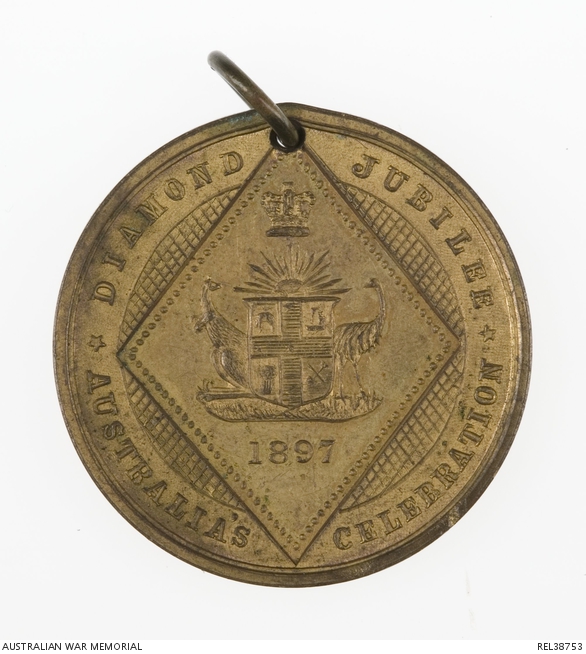| Places | |
|---|---|
| Accession Number | REL38753 |
| Collection type | Heraldry |
| Object type | Medalet |
| Physical description | Gilded bronze |
| Maker |
Stokes & Sons, Melbourne |
| Place made | Australia: Victoria, Melbourne |
| Date made | 1897 |
| Conflict |
First World War, 1914-1918 |
1897 Queen Victoria Jubilee medalet : Private A M Nicholson, 5 Battalion AIF


Medalet celebrating 60 years of the reign of Queen Victoria. The obverse has the busts of a young and an elderly Queen Victoria, around which are the words 'QUEEN VICTORIA'S 60TH YEAR OF REIGN 1837 TO 1897'. The reverse has a vertically aligned diamond in the centre, with the Australian coat of arms above the date '1897'. Around the diamond is the text 'DIAMOND JUBILEE AUSTRALIA'S CELEBRATION'. A hole is drilled through the top of the medalet, with a split ring threaded through it.
Medalet collected by 3368 Private Arthur Marshall Nicholson during his service in the First World War. Nicholson was born at Brighton, Victoria, the son of Samuel Henry and Hannah Eliza Nicholson. He was working as a grocer when he enlisted in the AIF on 7 July 1915. He embarked from Melbourne for Egypt on 11 October 1915 with the 11th reinforcements of 5 Battalion. Nicholson served in Egypt until 25 March 1916 when he embarked for France, arriving at Marseilles five days later. He served in France and took part in his unit's first major action in France, at Pozieres in the Somme Valley, in July 1916. On 24 December 1916 Private Nicholson was admitted to hospital with trench feet. He was sent to England and was in hospital until May 1917. He undertook further training at Perham Downs for two months before rejoining his unit in Belgium in late August 1917. On 20 September 1917 Nicholson took part in an attack at Menin Road, near Ypres in Belgium, capturing German territory. Throughout the following day, 21 September, German artillery fire harassed the Australian positions and as the day went on became increasingly accurate. At some point during the day, Private Nicholson was hit by shrapnel in his left leg and ankle. He was first treated by the 6th Australian Field Ambulance, who then transferred him to the 17th (British) Casualty Clearing Station, where he died of his wounds. He is buried at Lijssenthoek Military Cemetery in Belgium.
Share this page
Related information
Conflicts
Events
Subjects
People
Related Objects
- Wristwatch with mesh guard: Private A M Nicholson, 5 Battalion AIF
- Small shaving mirror in fabric pouch : Private A M Nicholson, 5 Battalion AIF
- 1914-15 Star : Private A M Nicholson, 5 Battalion AIF
- British War Medal 1914-20 : Private A M Nicholson, 5 Battalion AIF
- Victory Medal : Private A M Nicholson, 5 Battalion AIF
- Next of kin plaque : Private A M Nicholson, 5 Battalion AIF
- 1900 Peace Medalet South African War : Private A M Nicholson, 5 Battalion AIF
- Pendant made from 1898 Farthing, Great Britain : Private A M Nicholson, 5 Battalion AIF
- Pendant made from 1840 1/4 Rupee coin, East India Company : Private A M Nicholson, 5 Battalion AIF
- Pendant made from 1874 six pence coin, Great Britain : Private A M Nicholson, 5 Battalion AIF